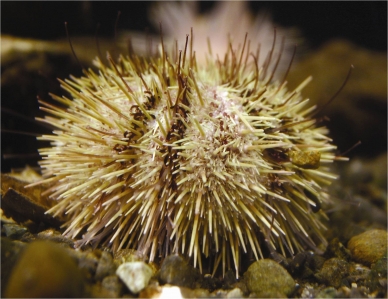Alaska Species Explorer
- Giant Pacific Octopus
- Red King Crab
- Moon Jelly
- Gumboot chiton
- Rose Star
- Green Sea Urchin
- Spot Prawn
All
x
- – No known individuals remaining.
- – Known only to survive in captivity, or as a naturalized population outside its historic range.
- – Extremely high risk of extinction in the wild.
- – High risk of extinction in the wild.
- – High risk of endangerment in the wild.
- – Likely to become endangered in the near future.
- – Lowest risk. Does not qualify for a higher risk category. Widespread and abundant taxa are included in this category.
- – Not enough data to make an assessment of its risk of extinction.
- – Has not yet been evaluated against the criteria.
Green Sea Urchin
- – No known individuals remaining.
- – Known only to survive in captivity, or as a naturalized population outside its historic range.
- – Extremely high risk of extinction in the wild.
- – High risk of extinction in the wild.
- – High risk of endangerment in the wild.
- – Likely to become endangered in the near future.
- – Lowest risk. Does not qualify for a higher risk category. Widespread and abundant taxa are included in this category.
- – Not enough data to make an assessment of its risk of extinction.
- – Has not yet been evaluated against the criteria.
Uutuk
Northern hemisphere, including some Arctic waters; in the Pacific south to northern Washington.
Rocky intertidal up to 1,150m (3,770 ft), most common from intertidal to 9m (30 ft)
Sea urchins have separate male and female individuals. They may use an environmental cue such as temperature or daylight hours to synchronize the release of their gametes into open water during spawning. Larval sea urchins pass through different planktonic stages before settling out of the water column to feed on the ocean floor. They grow larger by expanding the number and size of the hard calcite plates of their test.
Kelp and other algae, occasionally scavenge on fish and invertebrates. Sea urchins use their 5 radially arranged teeth to scrape and tear.
Green and red sea urchins are the only commercially harvested urchins in Alaska. They are harvested for their eggs which are considered a delicacy in many cultures. Green sea urchins are currently harvested by divers in a small area around Kodiak Island. A smaller commercial fishery that once existed in southeast Alaska was not sustainable. Ocean acidification is expected to have a detrimental effect on the growth of echinoderm skeletons, including the tests of sea urchin.
A sea urchin has 3 distinctive structures extending from its hard body wall or test: spines, tube feet and pedicellaria. Green sea urchin spines provide protection although they are not venomous. Tube feet are controlled by a water vascular system and are used for locomotion, food collection and holding onto small rocks and shells used for camouflage. Pedicellaria are thin, flexible stalks topped by a small claw-like structure that assist in food capture, protection and keeping the surface of the urchin clean of parasistes and debris.
- Aristotle’s lantern is the name given to the unique mouth structure of sea urchins. Their teeth are so strong and sharp that they can scratch and damage their aquarium habitats as they graze on the algae growing on the acrylic windows.
- Dry sea urchin tests are covered with hundreds of bead-like bumps. These are the pivot points on which the spines move.








